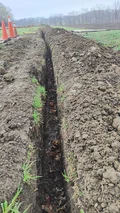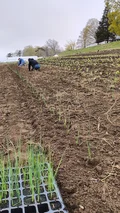TL;DR
We planted 6 rows of kohlrabi, broccoli, and leeks. I watered the greenhouse mid-day. Then we hoed 3 rows of scallions in the dry field.
Tomatoes Grow Up Quickly
To start, we potted up a bunch of tomato plants that were getting a bit leggy for 2-inch cells. These were started a few weeks ago and already need 6-inch pots. Eventually they’ll be planted into the trenches in the new greenhouse…which were worked on a bit today with the trencher.
Great Planting Conditions
The soil in the lower field had been freshly cultivated with very little compaction, so the job of planting two rows of kohlrabi and two rows of baby broccoli was easy on the hands. Still, planting by hand takes a toll on the back and knees, but for me it’s getting easier to go faster with less unnecessary strain.
Leeks Are Delicate Yet Hardy
Leeks are allums, so even if grown from seed they are dainty looking sprigs of green, they can easily be extracted from seed tray cells after watering and pulled apart during planting. Unlike other veg rows, the leeks are spread far apart…one on each side of a 4-foot bed about 3 feet apart and 8-10 inches between the rows. This gives them plenty of space for their greens to branch out, for the stalks to get big and beautiful, unblanched by the sun and still provide enough space to run a small manual cultivator between them during the season.
Don’t Begrudge the Kohlrabi
I don’t particularly care for kohlrabi, as neither do many consumers. It’s a turnip cabbage with all the pros and cons of both combined. So when we planted rows of it, all I wanted to do was go to my happy place and get it done quickly. But it is easy to grow, hardy for early season, and I’m sure there are ways to cook (with) it such that it isn’t just a culinary chore in your CSA. At least it comes with both stem and leaves, two textures in one, so maybe that’s positive.
Hoeing Around
After lunch, we planted the leeks then I watered the greenhouse because it was a relatively warm and sunny morning. Then we went out to the dry fields and used stirrup hoes around the tiny (but still living) scallion starts to terminate any grass weeds that were re-establishing. Weeding always seems like a boring chore to me, but it has to be done and there’s plenty to chat about while carefully working around the plants.
Ollama, My LLMa Summary
Main Themes:
- Farm work routine and daily activities
- Planting and harvesting various crops
- Farm operations and equipment use
Activities:
-
Completed tasks such as:
- Checking on crops and maintaining equipment
- Assisting with animal care (not mentioned)
- Observing and noting changes in weather patterns
- Participating in a farm tour or meeting with other staff
-
Collecting data or samples
-
Specific tasks performed by the intern on April 22nd included:
- Replacing potting mix, planting tomatoes, onions, kohlrabi, baby broccoli, leeks, scallions, kale, and bok choy, loading trucks, watering greenhouse, collecting trash, and weeding scallions
New Things Not Yet Encountered:
- Use of the trench digger in the greenhouse
- Tractor attachments (big fork tongs and disc attachment) for cultivating rows
- Row cover, fabric spikes, and low tunnel wire hoops (upcoming shipment)
Questions and Future Areas of Research:
- How to use gloves while hoeing to prevent splinters?
- What is the optimal spacing for planting leeks?
- How to properly handle and transplant seedlings from two-inch cells?
Suggested Actions:
- Review and practice proper technique for planting leeks
- Learn about different types of tractor attachments and their uses
- Consider visiting other farms to compare practices and learn new techniques
- Investigate ways to prevent splinters from occurring while working with sharp tools like hoes
- Research the benefits of using row cover, fabric spikes, and low tunnel wire hoops for greenhouse management
[end of post]
Enjoy Reading This Article?
Here are some more articles you might like to read next:








